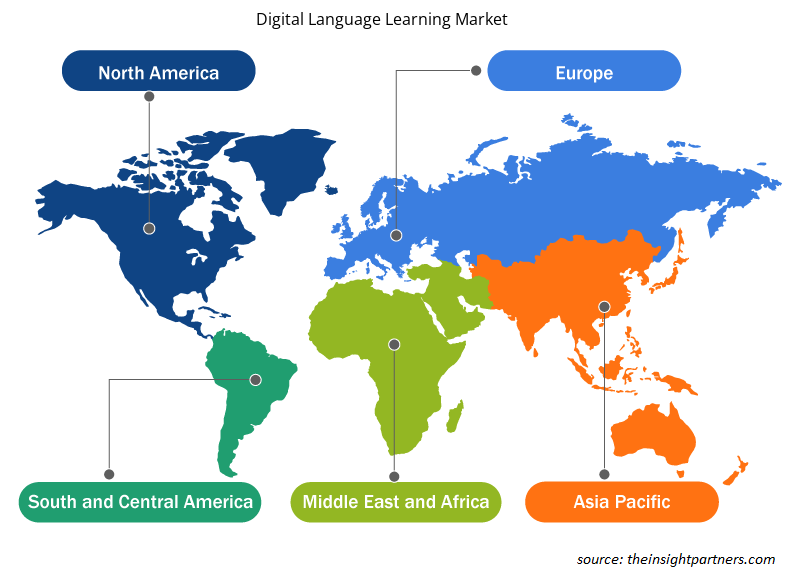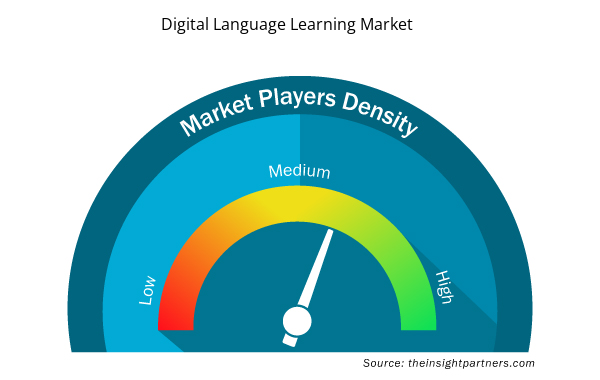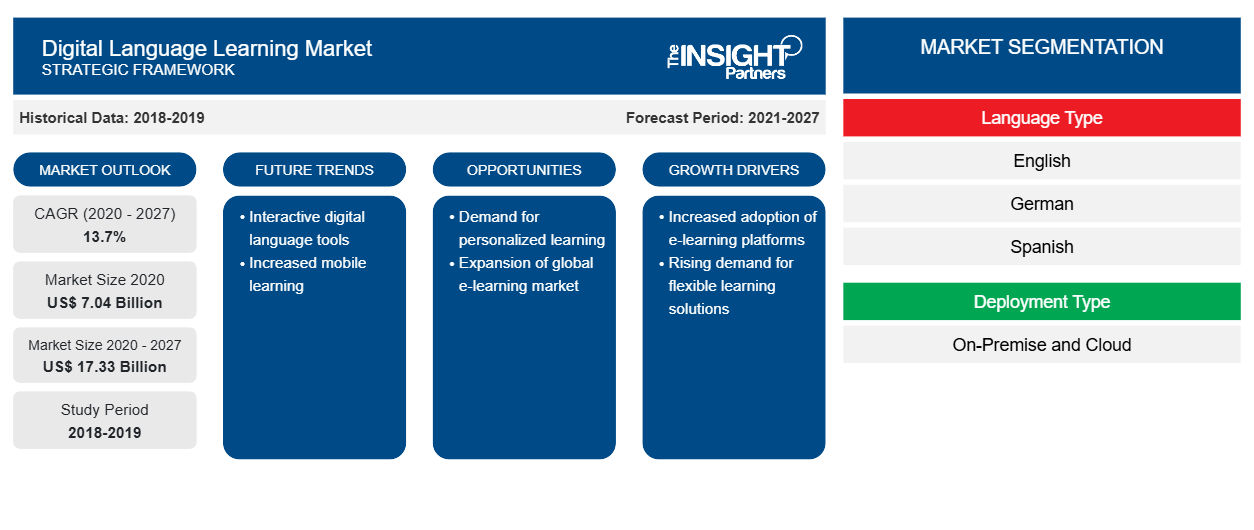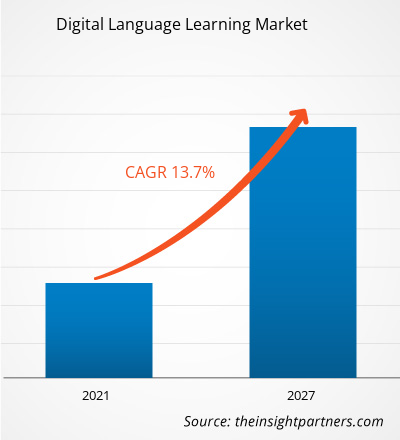数字语言学习市场预计将从 2020 年的 70.382 亿美元增长到 2027 年的 173.334 亿美元;预计 2020 年至 2027 年的复合年增长率为 13.7%。
各国政府实施英语学习计划的举措推动了市场的增长。在各国政府和私人组织为提供数字化增强性能而采取的各种举措的支持下,全球教育行业正在发生巨大变化。过去几年,中国、澳大利亚、巴西和阿联酋等各国政府都启动了数字教育计划,帮助这些国家提升了英语教育体系。例如,十年前澳大利亚政府发起的数字教育革命 (DER) 使多所学校和大学能够利用数字教育。同样,中国政府也出台了多项政策来推动数字教育,重点是英语学习,这推动了为中国学生提供数字学习解决方案的公司数量的增加。51Talk 是中国最著名的数字英语学习机构之一;17作业是另一个面向中国学生、教师和家长的数字平台,它以练习和家庭作业的形式提供在线作业,让最终用户提高他们的能力。目前,印度正在加紧为数字教育创造巨大的市场空间。印度政府采取了各种举措,以在教育领域推广数字化技术。SWAYAM 是印度政府实施的最突出的数字学习平台和举措,它帮助学生选择涵盖所有高等教育科目的在线课程。国际大学也被允许通过 SWAYAM 平台提供各自的课程和考试,这有助于学生学习和选择国际大学的考试。这一因素提高了学生的英语学习、口语和写作能力。国家数字图书馆是印度政府实施的另一项举措,旨在通过一站式设施提供虚拟学习资源来源。这一举措正逐渐受到重视,预计将推动印度数字英语学习市场在未来几年内增长,从而促进全球数字语言学习市场的增长
定制此报告以满足您的需求
您可以免费定制任何报告,包括本报告的部分内容、国家级分析、Excel 数据包,以及为初创企业和大学提供优惠和折扣
- 获取此报告的关键市场趋势。这个免费样品将包括数据分析,从市场趋势到估计和预测。
COVID-19 疫情对数字语言学习市场的影响
在过去的几个月里,新冠疫情的爆发给全球现有的教育部门带来了相当大的积极影响。此外,传统教育机构和课堂学习技术的中断见证了采用强大而高效的在线和数字学习解决方案的激增,预计在未来几年将继续推动市场在疫情过后的增长。例如,联合国教科文组织与几位来自科技企业和国际电信联盟 (ITU) 的主要代表合作,强调了在学习中采用数字技术的经济意义,以便在新兴经济体中,无需对物理基础设施进行大量投资,就能让更多的受众获得快速的学习能力。
然而,在剑桥大学进行的另一项调查中,超过 1,200 名受访者表示,在未来几年中,60% 的受访者更倾向于继续使用数字学习技术。因此,最近的疫情促进了数字学习技术的采用激增,并随后在过去几个月对市场增长产生了积极影响
市场洞察——数字语言学习市场
利用先进和简化的技术吸引学生接受数字教育
在美国和英国等发达国家,数字教育系统已获得极大的普及,因为学校、大学和其他机构的学生完全了解这些技术。然而,在亚太地区和 SAM 国家,学生缺乏技术驱动学习的意识。许多学校、大学和辅导机构正在课堂上实施数字技术。随着数字教育平台开发商不断升级其技术以提供强大的解决方案,亚太地区的采用者也在不断升级其技术基础设施。创新的基于云的教育应用程序、网站和其他服务预计将为数字教育(包括数字语言学习解决方案)创造一个巨大的市场。
基于语言类型的洞察
根据语言类型,数字语言学习市场分为英语、普通话、西班牙语、德语和其他语言。英语部分在 2019 年占据了最大的市场份额。
数字语言学习市场区域洞察
Insight Partners 的分析师已详细解释了预测期内影响数字语言学习市场的区域趋势和因素。本节还讨论了北美、欧洲、亚太地区、中东和非洲以及南美和中美洲的数字语言学习市场细分和地理位置。

- 获取数字语言学习市场的区域特定数据
数字语言学习市场报告范围
| 报告属性 | 细节 |
|---|---|
| 2020 年市场规模 | 70.4 亿美元 |
| 2027 年市场规模 | 173.3亿美元 |
| 全球复合年增长率(2020 - 2027 年) | 13.7% |
| 史料 | 2018-2019 |
| 预测期 | 2021-2027 |
| 涵盖的领域 | 按语言类型
|
| 覆盖地区和国家 | 北美
|
| 市场领导者和主要公司简介 |
|
市场参与者密度:了解其对商业动态的影响
数字语言学习市场正在快速增长,这得益于终端用户需求的不断增长,而这些需求又源于消费者偏好的不断变化、技术进步以及对产品优势的认识不断提高等因素。随着需求的增加,企业正在扩大其产品范围,进行创新以满足消费者的需求,并利用新兴趋势,从而进一步推动市场增长。
市场参与者密度是指在特定市场或行业内运营的企业或公司的分布情况。它表明在给定市场空间中,相对于其规模或总市场价值,有多少竞争对手(市场参与者)存在。
在数字语言学习市场运营的主要公司有:
- 巴贝尔
- 博树有限公司
- 流感病毒
- 凌格达有限公司
- 活的语言(企鹅兰登书屋有限责任公司)
免责声明:上面列出的公司没有按照任何特定顺序排列。

- 获取数字语言学习市场顶级关键参与者概述
数字语言学习市场的参与者主要致力于开发先进、高效的产品。
- 2019年,Fluenz宣布将于2020年春季将其西班牙奢华沉浸式体验项目扩展到西班牙巴塞罗那。用户可以参加该项目为期六天的语言学习。
- 2018 年,Preply, Inc. 宣布计划于 2019 年初在巴塞罗那开设新办事处。此次扩张是 7 月份获得 400 万美元融资的结果。该公司还计划扩大其在德国、英国、美国和拉丁美洲市场的影响力。
数字语言学习市场细分如下:
全球数字语言学习市场 - 按语言类型
- 英语
- 德语
- 西班牙语
- 普通话
- 其他的
全球数字语言学习市场 - 按部署类型
- 本地
- 云
全球数字语言学习市场 - 按业务类型
- 企业对企业
- 企业对客户
全球数字语言学习市场 - 按最终用户
- 学术的
- 非学术
全球数字语言学习市场 – 按地区划分
- 北美
- 我们
- 加拿大
- 墨西哥
- 欧洲
- 法国
- 德国
- 意大利
- 俄罗斯
- 英国
- 欧洲其他地区
- 亚太地区 (APAC)
- 日本
- 中国
- 澳大利亚
- 印度
- 韩国
- 亚太地区其他地区
- 中东和非洲 (MEA)
- 沙特阿拉伯
- 阿联酋
- 南非
- MEA 其他地区
- 南美洲 (SAM)
- 巴西
- 阿根廷
- SAM 其余部分
数字语言学习市场 – 公司简介
- 巴贝尔
- Busuu 有限公司
- 流感病毒
- 凌格达有限公司
- 活的语言(企鹅兰登书屋有限责任公司)
- 培生集团
- Preply 公司
- Rosetta Stone 公司
- Verbling 公司
- Yabla 公司
- 历史分析(2 年)、基准年、预测(7 年)及复合年增长率
- PEST 和 SWOT 分析
- 市场规模价值/数量 - 全球、区域、国家
- 行业和竞争格局
- Excel 数据集


- Virtual Event Software Market
- Pressure Vessel Composite Materials Market
- Greens Powder Market
- Hydrocephalus Shunts Market
- Airline Ancillary Services Market
- Rugged Phones Market
- E-Bike Market
- Rare Neurological Disease Treatment Market
- Semiconductor Metrology and Inspection Market
- Hydrogen Compressors Market

Report Coverage
Revenue forecast, Company Analysis, Industry landscape, Growth factors, and Trends

Segment Covered
This text is related
to segments covered.

Regional Scope
North America, Europe, Asia Pacific, Middle East & Africa, South & Central America

Country Scope
This text is related
to country scope.
常见问题
APAC region led digital language learning market. APAC comprises countries with developed educational sectors, including China, Australia, India, Singapore, and South Korea. These countries are leveraging every possible method and model to enhance English proficiency with an aim to increase the number of English speaking individuals. According to EF Education First English Proficiency Test, Asian countries hold the second position, after Europe, among the non-native English speaking countries. Over the years, countries in APAC have been investing significantly in promoting English language learning and also has lucrative opportunities for English learning.
Increasing number of Asian students migrating to western countries is the major factor driving the growth of the market. Digital English language learning is witnessing the major demand from the both academic and non-academic sectors in Asian countries. The currently increasing trend among Asian students to enroll themselves in universities in the western countries for higher education is creating a significant demand for language learning courses. Majority of the candidates from Asian countries, especially from India and China, enroll themselves for Test of English as a Foreign Language (TOEFL), International English Language Testing System (IELTS), Graduate Record Examination (GRE), Test of English for International Communication (TOEIC), and other language-based courses and certifications. TOEFL and IELTS are the tests conducted to assess a non-native candidate’s English fluency level, including proper English speaking and writing skills. This factor compels the enrolling candidates to opt for English Language Training (ELT) institutes. The burgeoning demand for these competitive exams has led to the establishment of various ELT institutions across these countries, which in turn has opened up avenues for different English learning methods.
English is the most preferred language in terms of business perspectives across the globe, and close to 30 nations worldwide have it as their primary language of communication. More than 20% of the global population speaks this language. As a result, various sectors around the world have given importance to English as a common language for communications. Further, on the back of the trending globalization, many businesses have been set in different parts of the world where English is a mandatory language for communication. Digital English language learning encompasses digital content and products that facilitate easy learning through the use of various ICT-enabled interactive tools. These tools include mobile applications, e-books, audio clips, videos, games, digital software, and online tutoring, among others. A few of the key companies operating in the digital English language learning market are Cambridge University Press, Cengage/ National Geographic Learning, and EF Education First
Trends and growth analysis reports related to Technology, Media and Telecommunications : READ MORE..
The List of Companies - Digital Language Learning Market
- Babbel
- Busuu Ltd
- Fluenz
- Lingoda GmbH
- Living Language (Penguin Random House, LLC)
- Pearson PLC
- Preply, Inc
- Rosetta Stone, Inc.
- Verbling, Inc
- Vabla, Inc
The Insight Partners performs research in 4 major stages: Data Collection & Secondary Research, Primary Research, Data Analysis and Data Triangulation & Final Review.
- Data Collection and Secondary Research:
As a market research and consulting firm operating from a decade, we have published and advised several client across the globe. First step for any study will start with an assessment of currently available data and insights from existing reports. Further, historical and current market information is collected from Investor Presentations, Annual Reports, SEC Filings, etc., and other information related to company’s performance and market positioning are gathered from Paid Databases (Factiva, Hoovers, and Reuters) and various other publications available in public domain.
Several associations trade associates, technical forums, institutes, societies and organization are accessed to gain technical as well as market related insights through their publications such as research papers, blogs and press releases related to the studies are referred to get cues about the market. Further, white papers, journals, magazines, and other news articles published in last 3 years are scrutinized and analyzed to understand the current market trends.
- Primary Research:
The primarily interview analysis comprise of data obtained from industry participants interview and answers to survey questions gathered by in-house primary team.
For primary research, interviews are conducted with industry experts/CEOs/Marketing Managers/VPs/Subject Matter Experts from both demand and supply side to get a 360-degree view of the market. The primary team conducts several interviews based on the complexity of the markets to understand the various market trends and dynamics which makes research more credible and precise.
A typical research interview fulfils the following functions:
- Provides first-hand information on the market size, market trends, growth trends, competitive landscape, and outlook
- Validates and strengthens in-house secondary research findings
- Develops the analysis team’s expertise and market understanding
Primary research involves email interactions and telephone interviews for each market, category, segment, and sub-segment across geographies. The participants who typically take part in such a process include, but are not limited to:
- Industry participants: VPs, business development managers, market intelligence managers and national sales managers
- Outside experts: Valuation experts, research analysts and key opinion leaders specializing in the electronics and semiconductor industry.
Below is the breakup of our primary respondents by company, designation, and region:

Once we receive the confirmation from primary research sources or primary respondents, we finalize the base year market estimation and forecast the data as per the macroeconomic and microeconomic factors assessed during data collection.
- Data Analysis:
Once data is validated through both secondary as well as primary respondents, we finalize the market estimations by hypothesis formulation and factor analysis at regional and country level.
- Macro-Economic Factor Analysis:
We analyse macroeconomic indicators such the gross domestic product (GDP), increase in the demand for goods and services across industries, technological advancement, regional economic growth, governmental policies, the influence of COVID-19, PEST analysis, and other aspects. This analysis aids in setting benchmarks for various nations/regions and approximating market splits. Additionally, the general trend of the aforementioned components aid in determining the market's development possibilities.
- Country Level Data:
Various factors that are especially aligned to the country are taken into account to determine the market size for a certain area and country, including the presence of vendors, such as headquarters and offices, the country's GDP, demand patterns, and industry growth. To comprehend the market dynamics for the nation, a number of growth variables, inhibitors, application areas, and current market trends are researched. The aforementioned elements aid in determining the country's overall market's growth potential.
- Company Profile:
The “Table of Contents” is formulated by listing and analyzing more than 25 - 30 companies operating in the market ecosystem across geographies. However, we profile only 10 companies as a standard practice in our syndicate reports. These 10 companies comprise leading, emerging, and regional players. Nonetheless, our analysis is not restricted to the 10 listed companies, we also analyze other companies present in the market to develop a holistic view and understand the prevailing trends. The “Company Profiles” section in the report covers key facts, business description, products & services, financial information, SWOT analysis, and key developments. The financial information presented is extracted from the annual reports and official documents of the publicly listed companies. Upon collecting the information for the sections of respective companies, we verify them via various primary sources and then compile the data in respective company profiles. The company level information helps us in deriving the base number as well as in forecasting the market size.
- Developing Base Number:
Aggregation of sales statistics (2020-2022) and macro-economic factor, and other secondary and primary research insights are utilized to arrive at base number and related market shares for 2022. The data gaps are identified in this step and relevant market data is analyzed, collected from paid primary interviews or databases. On finalizing the base year market size, forecasts are developed on the basis of macro-economic, industry and market growth factors and company level analysis.
- Data Triangulation and Final Review:
The market findings and base year market size calculations are validated from supply as well as demand side. Demand side validations are based on macro-economic factor analysis and benchmarks for respective regions and countries. In case of supply side validations, revenues of major companies are estimated (in case not available) based on industry benchmark, approximate number of employees, product portfolio, and primary interviews revenues are gathered. Further revenue from target product/service segment is assessed to avoid overshooting of market statistics. In case of heavy deviations between supply and demand side values, all thes steps are repeated to achieve synchronization.
We follow an iterative model, wherein we share our research findings with Subject Matter Experts (SME’s) and Key Opinion Leaders (KOLs) until consensus view of the market is not formulated – this model negates any drastic deviation in the opinions of experts. Only validated and universally acceptable research findings are quoted in our reports.
We have important check points that we use to validate our research findings – which we call – data triangulation, where we validate the information, we generate from secondary sources with primary interviews and then we re-validate with our internal data bases and Subject matter experts. This comprehensive model enables us to deliver high quality, reliable data in shortest possible time.


 获取此报告的免费样本
获取此报告的免费样本